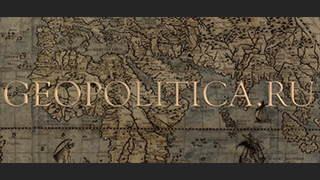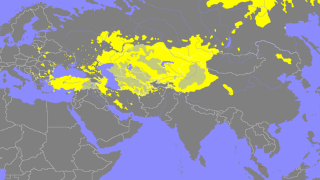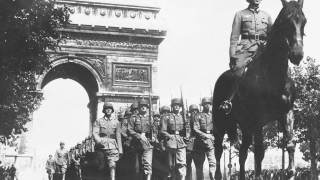The War in Nagorno-Karabakh: Endless Conflict
Understanding contemporary issues, especially new political conflicts and learning from them, is the only correct lesson to be learned from them. It is important to identify the causes of such conflicts and to make a political assessment of them and to predict the development of the process. An example of such an armed conflict is the conflict between Armenia and Azerbaijan. The people of the Caucasus have been suffering from this political and geopolitical issue for many years. Who are the perpetrators of this issue, and what political forces are behind this controversial issue and what are the benefits of this is the most important issue around Nagorno-Karabakh. Neither through war nor through peaceful means - negotiations have failed to help resolve the war. If in the past and in the new era, after each war, they sat at the negotiating table, it did not mean the rise of "common sense", but the preparation for the next war. Thus, here is a look at the past and present of the Armenian-Azerbaijani war over Nagorno-Karabakh, which has reached a qualitatively new level.
The armed conflict between the Republic of Azerbaijan and the Republic of Armenia over Nagorno-Karabakh, with its political and humanitarian implications, is one of the largest and longest-running inter-state regional conflicts in the post-Soviet space. It has inflicted heavy casualties and the parties to the conflict have suffered a lot, but the consequences of the actions of the parties are really worrying. They start a war and, after heavy losses, turn to mediators and negotiators. A comprehensive solution to this problem has not yet been developed, as the issue itself is complex and complicated. The formation of this complexity and complexity dates back to the territorial divisions of the 1920s, and it has gained legal force, which is no longer satisfactory to the parties.
Nagorno-Karabakh is a region in the Caucasus in the eastern part of the Armenian Mountains. According to the border-administrative division, Nagorno-Karabakh, in which 90% of the population was ethnically Armenian, became part of Azerbaijan. Thus, the main reason for the unresolved Nagorno-Karabakh conflict is the border dispute and the unresolved territorial dispute between Azerbaijan and Armenia. In particular, the Armenian region is located inside Azerbaijan. The Nagorno-Karabakh conflict has deep historical roots. Efforts to resolve it have already been made in Tsarist Russia in 1813 and 1828, in the RSFSR in 1918, and in the Soviet Union in 1945 and 1988. The Nagorno-Karabakh conflict arose in the political space of the Soviet Union in 1988, and after its dissolution automatically became an important issue for the two newly independent states, Azerbaijan and Armenia. On December 10, 1991, a referendum was held in Nagorno-Karabakh in full compliance with Article 1, paragraph 2, of the UN Charter, which called on the people of Nagorno-Karabakh to gain full independence from Azerbaijan. Nagorno-Karabakh declared itself an autonomous republic and did not receive international recognition and approval.
Analysis of the literature and sources show that the territorial claim of the Armenian side against Azerbaijan from the very beginning was the creation of a "Greater Armenia" at the expense of Azerbaijani lands and the expansion of its territory. During the years of Soviet rule, the issue of Nagorno-Karabakh was raised several times and failed to achieve its goals. Therefore, an important moment in the historical process was awaited. Karabakh is one of the historical districts of Azerbaijan. The title of Karabakh represents an integral part of Azerbaijan. It is derived from the Azeri-Turkish word “qara”, “gara” (black) and “bag” - garden. Naturally, due to this and other historical materials, Karabakh was a region of Azerbaijan.
According to the Kurekchay Treaty, the Karabakh Khanate will be subordinated to Russia as Muslim-Azerbaijani land. The Treaty of Kurekchay is a reliable document that reflects the historical reality and shows that it belongs to Azerbaijan. Under the Treaty of Kurekchay in 1805, the Karabakh Khanate was practically annexed by Russia. The ethnic composition of Karabakh finds expression in a special "Inscription" commissioned by the Russian general in the Caucasus, A.P Yermolov. According to this document, out of 20,095 families in Karabakh province, 15,729 were Azerbaijanis, 4,366 were Armenians, and the same number were Albanians. As a result of the mass settlement of Armenians in Karabakh, Armenian villages appeared in this province. According to official data, from 1828 to 1830, 40,000 Armenians settled in Northern Azerbaijan from Iran and 90,000 from the Ottoman Empire.
Thus, Tsarist Russia created favorable conditions for the mass migration of Armenians to North Azerbaijan, and especially for their political, administrative, social and cultural development. Thus, the Armenian side began to implement the idea of a "Greater Armenia" on Azeri lands. One of the main components of this operation was the massacre of the indigenous population in Karabakh, Yerevan, Nakhichevan and other lands. From 1890, after the uprising against the Ottoman Empire, Northern Azerbaijan became the center of the struggle. Similar struggles took place between Armenians and Azerbaijanis in 1905-1906, and then, taking advantage of the situation in the First World War, the Armenians became involved in the implementation of their mythical country - "Greater Armenia".
In 1915, after the failure of the Armenian uprising against the Ottoman Empire, which was carried out by the British, the Armenians suffered heavy losses. However, after the fall of the tsarist government in Russia and the coming to power of the Bolsheviks, the situation of anarchy in the Caucasus deteriorated, and the relations between Armenians and Azeris deteriorated.
On May 28, 1918, the Azerbaijani people established their state in Northern Azerbaijan. The Declaration of Independence of the Democratic Republic of Azerbaijan declares that it is the heir to the lands of Northern Azerbaijan previously occupied by Russia. Azerbaijan also considered Karabakh an integral part of its territory. At the same time, the Republic of Armenia announced its claim to Karabakh. Taking this situation into account, Azerbaijan formed the Karabakh Province in January 1919, which included the administrative units of Shushin, Javanshir, Jabrail and Zangezur. Karabakh became autonomous in 1923, was renamed the Nagorno-Karabakh Autonomous Okrug, and was abbreviated on the new borders of Azerbaijan. Thus, an integral part of Azerbaijan, Karabakh, was artificially divided into the Karabakh Valley and the Nagorno-Karabakh Republic. Azerbaijan had to be given autonomy due to the settlement of Armenians in Nagorno-Karabakh.
Naturally, the issue of Nagorno-Karabakh was not an issue during the Soviet era, especially until the 1980s. Controversial national issues were silenced by the demands of the state ideology, according to which the national question was resolved in the Soviet Union. However, from the late 80s of the twentieth century, especially since the last years of the Soviet Union, the old flaws gradually appeared. Another inter-ethnic clash in Nagorno-Karabakh in the autumn of 1988 aggravated the situation. In late November and early December, organized Armenian armed forces launched a large-scale operation that pushed the Azeris out of the area. This situation worsened the situation in the region, leading to the USSR leadership headed by M. Gorbachev intervened to help stabilize the political and military situation in Nagorno-Karabakh. Taking advantage of this situation, the leadership of the separatist movement, on September 2, 1991, raised the issue of establishing a "Nagorno-Karabakh Republic" on the territory of the autonomy and began to formalize their actions.
As a result of the Armenian aggression in 1993-1994, seven districts in the vicinity of Nagorno-Karabakh in Azerbaijan, such as Kalbajar, Lochin, Kubatlin, Jabrail, Zangilan, Agdam, and Fizulin, were annexed. As a result of the internal political crisis in Azerbaijan and the invasion of Armenia, 14,000 hectares of land were seized. About 1 million people have been displaced and forced to flee the region. As a result of the war, 20,000 people were killed, 50,000 others were injured and 5,000 people went missing. The damage from the war was estimated at $ 56 billion. In May 1994, the Bishkek Protocol on Reconciliation was signed. On May 12, 1994, active military operations on the front line came to an end. The future of the conflict in Nagorno-Karabakh is not a direct continuation of previous conflicts, ie there will be changes in the object of the conflict. First of all, historical diplomatic events are measured by other criteria after reconciliation. In particular, this statement by President Ilham Aliyev is proof of the above: “We are certainly pleased with the diplomatic achievements. But if our lands are still under occupation, then all these results are of no fundamental value. They will become important when the Azerbaijani lands are liberated from the occupying forces and our compatriots return to their native lands. ”
Thus, the Nagorno-Karabakh conflict continued in a qualitatively new form in 2016. In April 2016, a new war broke out between Azerbaijan and Armenia over Nagorno-Karabakh, known as the Four Days War. In the course of the war, Azerbaijan was able to fight for 20 km and thus put an end to this problem. Russia's mediation is crucial in ending the conflict. In 2018, a liberal politician, Nikol Pashinyan, came to power in Armenia. Previously, he was a member of parliament from the Elk bloc, advocating for Armenia's withdrawal from the Eurasian Economic Union. The new Armenian prime minister has taken a two-pronged stance on Nagorno-Karabakh. On the one hand, it encouraged Azerbaijan to allow Baku and Stepanakert to hold direct talks, which the Azerbaijani leadership did not agree with. On the other hand, he faced a political confrontation with the leadership of Nagorno-Karabakh, which led to the overthrow of Armenian leader Serzh Sargsyan in a 2018 protest in Yerevan. Relations between Armenia and Russia have weakened due to Pashinyan's pro-Western leanings, and Russia's political elite has naturally disagreed.
Russia maintains friendly relations with Armenia, which has the only Russian military base in the Caucasus in Gyumri (Russian 102nd Military Base). At the same time, Azerbaijan is an important geopolitical and economic partner of Russia. Russia has little interest in a full-scale war between Azerbaijan and Armenia. In any case, the war in the Caucasus will have a negative impact on regional security, which is not to Russia's liking. If Russia supports Yerevan on the issue, it will lose Azerbaijan. The North-South corridor project, which is supposed to connect Russia with Iran and India, is collapsing. NATO bases could be found in the Caspian Basin. Withdrawal of Yerevan's assistance will also help Armenia emerge from Eurasian integration structures. In this case, the Russian military will be forced to withdraw from Armenia and the United States will not replace it. In this regard, Russia, as a mediator and a third party, needs to resolve the conflict between Armenia and Azerbaijan in a way that does not reduce Russia's influence in the Caucasus and maintains its status quo.
The armed conflict in Nagorno-Karabakh began on September 27, 2020, and is a large-scale high-intensity war between the armed forces of Azerbaijan and the unrecognized units of the Nagorno-Karabakh Republic. Intensive military operations have taken place in the direction of Gadrut-Jibrail in the Araks Valley, which is the natural border between Azerbaijan and Iran. At the start of the next war, Azerbaijani President Ilham Aliyev addressed the nation, saying he would resolutely resolve the Nagorno-Karabakh conflict. The attack by Azerbaijani forces began on the morning of 27 September with extensive use of units. In Armenia and Nagorno-Karabakh, a state of war and general mobilization were declared. A state of war has been declared throughout Azerbaijan and curfews have been imposed in a number of districts.
Thus began another war around Nagorno-Karabakh. The Turkish side criticized the OSCE Minsk Group for not resolving the issue between Azerbaijan and Armenia and openly supported Azerbaijan. He described Armenia as a factor of insecurity in the region and provided military assistance to Azerbaijan. Other countries called on the parties to come to negotiations and resolve the issue peacefully. States such as France and the United States sought to mediate through mediation. Similarly, on October 10, 2020, the Russian side, through the Ministries of Foreign Affairs of Armenia and Azerbaijan, declared a ceasefire. But soon the sides broke the ceasefire.
The latest armed conflict between Azerbaijan and Armenia over Nagorno-Karabakh varies in intensity. The parties used heavy military equipment, unmanned aerial vehicles, inflicted material losses, loss of life in the national economy and similar violations in the military sector. Given the consequences of the war, the other countries called for reconciliation, but the warring parties continued to fight. It is important to note that a lack of resources to fight the war and weakening the military is one way to end the war. The same rule applies to Armenia. Armenia lacked military capabilities and human resources, so it surrendered.
It was on November 10, 2020, after six weeks of fighting between Azerbaijan and Armenia, that the war came to an end. The Armenian side surrendered and the Azerbaijani side was declared the winner. Under the new conditions, there are few wars that can end in this way.
At the end of October and the beginning of November 2020, the Armenian Defense Forces suffered a heavy defeat in the southern part of Karabakh. Azerbaijani troops entered a strategically important part of Shusha as a result of the battle on November 5-7, 2020. Shusha is located 10 km from Stepanakert, the capital of the unrecognized republic of Nagorno-Karabakh. At the same time, in Shusha and in the western part of the city, Azerbaijani forces cut off the main road connecting the center of Karabakh with Armenia. After this incident, as the Prime Minister of Armenia Nikol Pashinyan acknowledged, it became clear that the Armenians could lose the entire territory of Karabakh. As a result, Nicole Pashinyan agreed to sign what she described as a “painful” deal.
The main points of the agreement taken from the statements of the President of Russia, the President of Azerbaijan and the Prime Minister of Armenia are as follows:
- Armenia and Azerbaijan cease all military operations in Nagorno-Karabakh and keep troops in their positions. The ceasefire is monitored by a special peacekeeping center.
- The parties exchange hostages, prisoners and bodies of victims.
- Russian peacekeepers will remain in Karabakh for five years, and their future presence will be extended by mutual consent. They occupy an adjacent line.
- The city of Shusha remains under Azerbaijani control.
- Armenia needs to return to Azerbaijan three districts - Agdam, Kalbajar and Lachin. Stepanakert, Mardavert, Martuni and the former part of the Nagorno-Karabakh Autonomous Region, which is not occupied by the Azerbaijani army, remain under the control of Armenian forces.
- In Lachin district, there is a 5 km wide corridor for the connection of Karabakh with Armenia. It is controlled by Russian peacekeepers. According to the text of the agreement, control of peace in the region will fall to the Russian military. For this purpose, the presence of 1,960 peacekeepers, 90 armored personnel carriers and 370 units of vehicles and special equipment in Karabakh is envisaged.
- Armenia is obliged to ensure the security of relations between Azerbaijan and the Nakhchivan Autonomous Republic. The Russian military controls the corridor.
- Internally displaced persons and refugees return to Nagorno-Karabakh, which is under the control of the UN High Commissioner for Refugees.
Thus, the next war between Armenia and Azerbaijan ended, and the Azerbaijani army took the lead. Despite the fact that the war was short-lived, the losses on both sides were enormous. Of course, this is not the end of the matter, Karabakh will continue to be black and hot, and sooner or later the parties to the dispute will return to the issue.







